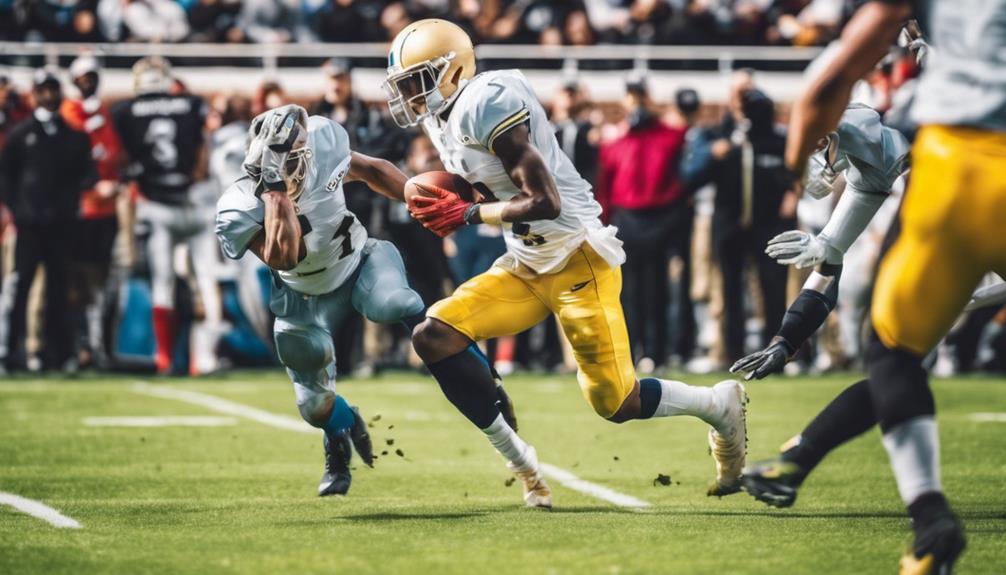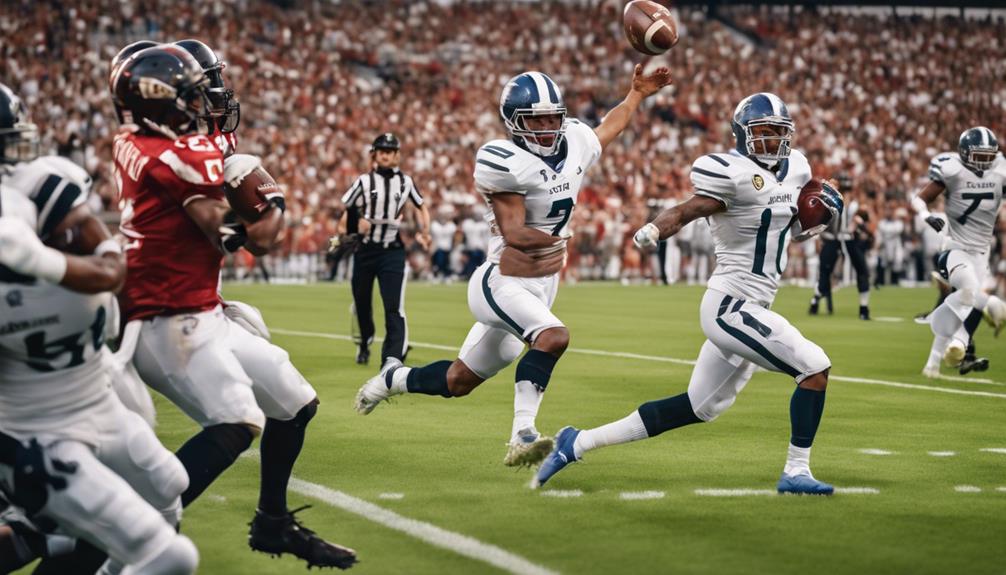In football, a takeaway is a game-changing defensive maneuver that can alter the course of a match in an instant. Imagine the thrill of intercepting a pass or recovering a fumble, turning the tide in your team's favor. But what makes takeaways so significant beyond the immediate turnover? Stay tuned to uncover the strategic nuances, statistical impact, and memorable moments that make takeaways a fundamental aspect of defensive play in football.
Key Takeaways
- A takeaway in football is a defensive play involving interceptions or fumble recoveries.
- It shifts momentum, creates scoring opportunities, and showcases defensive skills.
- Takeaways can be interceptions or fumble recoveries, leading to sudden possession changes.
- They are crucial for denying opponents scoring chances and inspiring defensive prowess.
- Understanding takeaways vs. turnovers is vital for defensive strategies in football.
Definition of a Takeaway

When discussing football, a takeaway refers to a defensive play where the defense gains possession of the ball from the offense through an interception or a fumble recovery. Takeaways are pivotal moments in a game as they can shift momentum and create scoring opportunities for the defense.
Interceptions occur when a defensive player catches a pass intended for an offensive player, effectively stopping the offensive drive and giving possession to the defense. On the other hand, a fumble recovery happens when a defensive player gains control of the ball after it has been dropped or knocked loose by the offense.
Being able to consistently create takeaways is a hallmark of a strong defensive unit. Defensive players train rigorously to improve their skills in intercepting passes and forcing fumbles.
Coaches often emphasize the importance of takeaways in practice sessions to instill a defensive mindset focused on disrupting the opponent's offense. Mastering the art of takeaways can elevate a team's performance and lead to victories on the football field.
Types of Takeaways
Explore the various types of takeaways that can occur in a football game. One common type is an interception, where the defense catches a pass intended for an offensive player. Interceptions can lead to sudden changes in possession and scoring opportunities.
Another type of takeaway is a fumble recovery, which happens when a defensive player gains possession of the ball after it has been dropped or knocked loose by an offensive player. Fumble recoveries can swing the momentum of a game and create scoring chances for the recovering team.
Additionally, a quarterback sack is a type of takeaway where the defense tackles the quarterback behind the line of scrimmage, resulting in a loss of yards for the offense. Sacks can disrupt offensive plays and force turnovers.
Understanding these different types of takeaways can help you appreciate the impact they've on the outcome of a football game.
Importance of Takeaways

Understanding the significance of takeaways in football can greatly impact a team's ability to control the game and secure victory. Takeaways, such as interceptions and fumble recoveries, not only shift momentum but also provide teams with additional scoring opportunities.
When your team forces a turnover, it not only denies the opponent a chance to score but also sets your offense up with a shorter field, increasing the likelihood of putting points on the board.
Moreover, takeaways can demoralize the opposing team, affecting their confidence and decision-making. By consistently creating turnovers, your team can disrupt the rhythm of the opponent's offense, leading to potential errors and missed opportunities.
Additionally, the ability to generate takeaways showcases a team's defensive prowess and playmaking skills, earning respect from fans, opponents, and analysts alike.
Ultimately, mastering the art of takeaways can be the key to turning the tide of a game in your team's favor and securing pivotal victories on the football field.
Difference Between Takeaway and Turnover
Differentiating between a takeaway and a turnover is essential in understanding defensive strategies in football. Takeaways occur when the defense gains possession of the ball from the offense through interceptions, fumble recoveries, or forcing a turnover on downs. On the other hand, turnovers encompass a broader range of offensive mistakes that result in loss of possession, including interceptions, fumbles, and failed fourth-down conversions.
The key distinction lies in the intentionality behind the actions. Takeaways are actively forced by the defense through skillful playmaking, while turnovers can result from offensive errors or defensive pressure. Understanding this nuance is critical for coaches and players to hone their defensive tactics.
By focusing on creating takeaways, defenses aim to disrupt the opponent's momentum and create scoring opportunities for their own team. Conversely, turnovers can sometimes stem from misplays or miscommunications within the offense.
Recognizing the difference between takeaways and turnovers enables teams to strategize effectively and capitalize on defensive opportunities.
How Takeaways Impact Momentum

When it comes to football, takeaways play a significant role in shifting momentum on the field. Imagine this – your team is trailing, and the opposing offense is driving down the field with ease. Suddenly, your defense forces a fumble, intercepts a pass, or causes a turnover. The energy on the field shifts instantly.
Your team gains possession, the crowd roars with excitement, and your players are fueled with adrenaline. This sudden change in possession not only gives your team a chance to score but also demoralizes the opposing team.
Takeaways have the power to swing the momentum of a game dramatically. They can turn the tide from a defensive struggle to an offensive surge in a matter of seconds. A single takeaway can inspire a team to play with greater intensity, focus, and determination. It can be the turning point that leads to a series of successful plays and ultimately changes the course of the game.
Strategies to Force Takeaways
To increase your team's chances of forcing takeaways in football, focus on implementing strategic defensive plays and capitalizing on the opposing team's mistakes.
One effective strategy is to apply pressure on the quarterback by utilizing blitz packages or stunts to disrupt their timing and decision-making. By hurrying the quarterback, you can force errant throws or create fumbles, enhancing the likelihood of a turnover. Additionally, emphasizing proper tackling techniques and gang tackling can help strip the ball from the ball carrier or receiver.
Another key tactic is to study your opponents' tendencies and weaknesses. By scouting their previous games and analyzing their gameplay, you can identify patterns that may lead to potential turnovers. For instance, if a particular receiver has a history of fumbling under pressure, you can target them in your defensive schemes.
Moreover, practicing ball awareness drills can train your defense to react quickly to loose balls and capitalize on recovery opportunities. By honing these skills and executing strategic plays, you can significantly improve your team's ability to force takeaways and shift the momentum in your favor.
Statistical Significance of Takeaways

Exploring the statistical significance of takeaways in football can provide valuable insights into their impact on game outcomes and team performance. Takeaways, which include interceptions and fumble recoveries, are pivotal moments in a game that can shift momentum and lead to scoring opportunities.
Teams that excel in generating takeaways often have a competitive edge due to the increased chances of scoring off turnovers.
Statistically, the correlation between the number of takeaways a team achieves and their overall success is significant. Research shows that teams with a higher takeaway differential, meaning they generate more takeaways than they concede, tend to win more games. This differential is a strong indicator of a team's defensive prowess and ability to capitalize on opponent mistakes.
Moreover, analyzing the impact of takeaways on field position and scoring drives reveals their importance in determining game outcomes. Teams that consistently capitalize on takeaways by converting them into points demonstrate the direct influence these defensive plays have on overall performance.
Famous Takeaway Moments
Several iconic moments in football history have been defined by remarkable takeaway plays that changed the course of games. One standout moment is the 'Immaculate Reception' in 1972 when Pittsburgh Steelers' Franco Harris caught a deflected pass and ran for a game-winning touchdown. This play is etched in football lore as one of the most miraculous takeaways in NFL history.
Another unforgettable takeaway moment is Malcolm Butler's interception at the goal line during Super Bowl XLIX, sealing the victory for the New England Patriots. This interception thwarted the Seattle Seahawks' potential game-winning touchdown and showcased the impact a single takeaway can have on the outcome of a game.
Additionally, Charles Woodson's forced fumble in the 2001 AFC Divisional Playoff game against the New England Patriots was a pivotal takeaway that helped propel the Oakland Raiders to victory. These famous takeaway moments exemplify the game-changing potential of defensive plays in football.
Conclusion
Now that you understand what a takeaway is in football, remember that these defensive plays can make or break a game.
Whether it's an interception or a fumble recovery, takeaways are essential for shifting momentum and creating scoring opportunities for the defense.
Keep practicing and strategizing to force more takeaways, and watch how these pivotal moments can change the course of a game in your team's favor.




